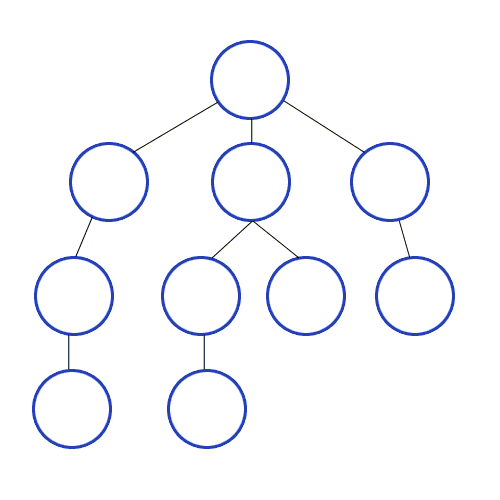Learn the basic algorithms for traversing trees and graphs.
Breadth-First Search
DFS vs. BFS
DFS is a simple algorithm, but the path it finds to a Node may not be the shortest. In cases where that matters, you'll want to use Breadth-First Search (BFS) instead. Instead of following a path all the way to the end, BFS goes through a graph one level at a time:
You can view BFS in action with this Algorithm visualizer. Pick a start vertex and then click Run BFS.
BFS Algorithm
BFS begins at one node in a graph and visits all the neighboring nodes. It then goes to each of those neighbors to explore their unvisited neighbors in order. So it goes through the entire graph one level at a time, until the whole graph has been visited.
DFS was simple to implement, since you could use recursion to stack up the Nodes. However, BFS goes through the Nodes one level at a time, so you need a structure to keep track of the next nodes to be processed.
Q: What structure can be used to access items in the order they were put in?
A: A Queue (such as a LinkedList).
Before clicking below, see if you can describe of an Algorithm that uses a Queue to print the Nodes in a Graph in BFS order.
In the description below, to process a Node means to mark the Node as visited, add it to the queue and print out its value,.
BFS Algorithm:
- Create a Queue for keeping track of the nodes or numbers that still need to be explored.
- process the starting Node. As long as you still have nodes in the Queue:
- Dequeue a Node and get its adjacent nodes as a list
- process every adjacent node in the list that's not yet visited.

BFS on sample input. Marks node red when visited, and grey when finished with.
Challenge
Create a graph from the given input and print it out in BFS order.
Input/Output Format
The Input and output format are the same as the previous graph challenges. Print out the graph in BFS order, with each graph on its own line. (You can use the provided boilerplate code to get a graph as a list of lists.)
Sample Input
Hover over numbers for more info
1 6 2 4 5 0 3 2 1 5 4 2
Sample Output
0 2 5 3 4 1
Explanation
This is the order of the BFS search, as seen in the above animation.
For this challenge, visit equivalent nodes in the same order as their line of input. For example, 5 comes before 3 in the output since it was before 3 in the input.
Using BFS
BFS can be used whenever you need to search a graph, such as in the Connected Components challenge. BFS is necessary to search a graph one level at a time, such as finding the shortest path to a node. BFS is also necessary for searching a graph without a clear ending, which will be covered in future AI challenges.
Challenge
Print out a Graph in BFS order
Please sign in or sign up to submit answers.
Alternatively, you can try out Learneroo before signing up.


Comments
Igor Naverniouk
Sep 17, 3:34 PMWhy is "0 2 3 5 4 1" not a correct answer for input #1?
Learneroo
Sep 17, 3:41 PMIt's a valid BFS, but for this challenge you should visit nodes on one level in the order they were in their line of input.
Igor Naverniouk
Sep 17, 3:49 PMThat's not specified in the problem statement.
Learneroo
Sep 17, 4:04 PMThanks. It was mentioned previously, and I updated it so it's mentioned here as well.